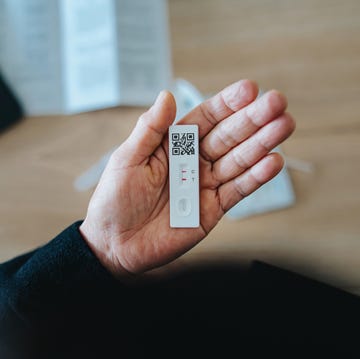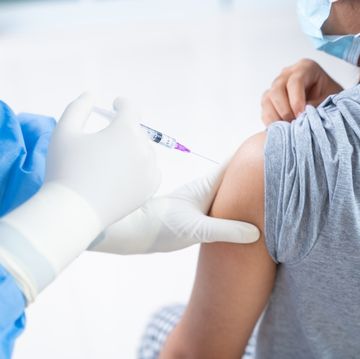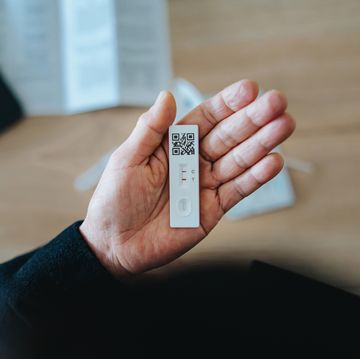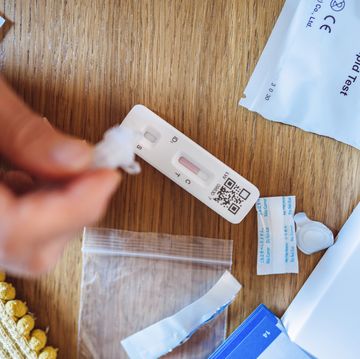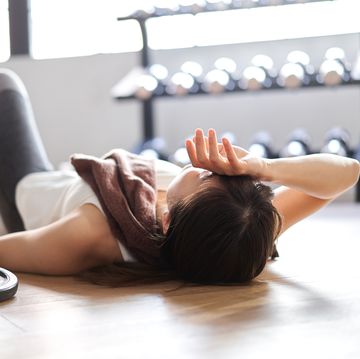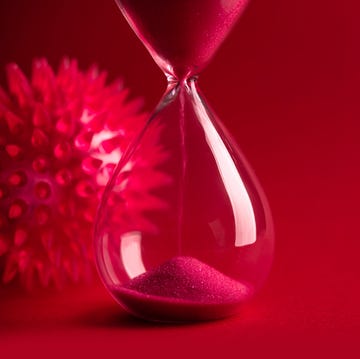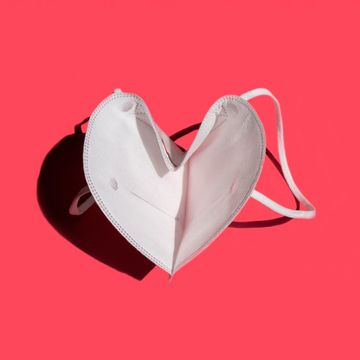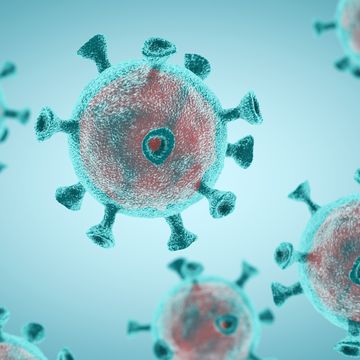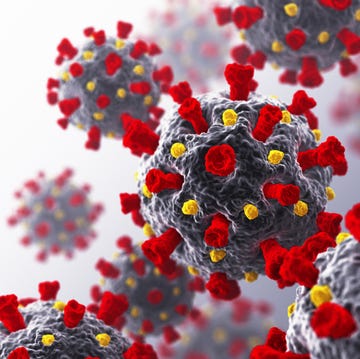Jump to:
- How do home COVID tests work?
- What is a false positive COVID-19 test?
- How common are false positive COVID-19 tests?
- How common are false negatives on rapid tests?
- What if my COVID-19 test is expired?
- How can you avoid false positives from rapid COVID tests?
- What should you do if you test positive on an at-home test?
- Can you still get free COVID tests in 2023?
- Are at-home tests still effective at detecting the newest variants?
For most people, having an at-home COVID test or two handy is just a normal part of life these days. But, if you happen to take a test and get a positive you weren’t expecting, it’s more than understandable to wonder what causes a false positive COVID test—and if you could be experiencing one.
But how accurate are antigen tests? False positive COVID-19 tests—when your result is positive, but you aren’t actually infected with the SARS-CoV-2 virus—are a real, if unlikely, possibility, especially if you don’t perform your at-home test correctly.
Still, “these are pretty rare,” says Thomas Russo, M.D., a professor and the chief of infectious diseases at the University at Buffalo in New York, noting that “false negatives are much more likely to happen.”
Meet the experts: Thomas Russo, M.D., a professor and the chief of infectious diseases at the University at Buffalo in New York; Geoffrey Baird, M.D., Ph.D., professor and chair of the Department of Laboratory Medicine and Pathology at the University of Washington School of Medicine; and David Cennimo, M.D., infectious disease expert and associate professor of medicine and pediatrics at Rutgers New Jersey Medical School.
So, how can you know if you’re dealing with a false positive? There’s a lot to unpack here, including what may cause this in the first place. Experts break it down.
How do home COVID tests work?
Most home COVID tests are what’s known as rapid antigen tests. They usually involve you taking a sample from your nose and give you results within 15 minutes.
These self tests don’t detect antibodies that would indicate that you had a previous infection or measure your immunity, per the Centers for Disease Control and Prevention (CDC). Instead, Dr. Russo explains, they look for a protein that’s on the covering of the virus. “The tests have an antibody that reacts with the protein,” he says. “They have a solution that breaks the virus down and the parts then react with that antibody.” If you have the virus in your body, the test should deliver a band in your test results or say that it’s positive. If not, it should give you a negative test result.
What is a false positive COVID-19 test?
“False positive” means that you have been delivered a positive result, but are not actually infected with the SARS-CoV-2 virus.
In the most basic sense, there are four possible outcomes for a COVID-19 test, whether it’s molecular PCR or rapid antigen: true positive, true negative, false positive, and false negative. “True” and “false” refer to the accuracy of the test, while “positive” and “negative” refer to the outcome you receive, says Geoffrey Baird, M.D., Ph.D., professor and chair of the Department of Laboratory Medicine and Pathology at the University of Washington School of Medicine.
How common are false positive COVID-19 tests?
First, a crash course in virus testing vocabulary: “Sensitivity” measures a test’s ability to accurately identify people who have COVID-19, Dr. Baird says. “Specificity,” meanwhile, refers to a test’s ability to correctly identify people who do not have the virus. Specificity will generally be higher than sensitivity, especially when people have COVID-19 symptoms—in other words, false-negative COVID-19 tests are more likely than false positives.
All rapid tests currently authorized for home use by the Food and Drug Administration (FDA) have high sensitivity and specificity, meaning they have a high accuracy rate.
The false positive rate on rapid antigen testing is rare. One study from 2022 estimated that 0.05% of positive tests were false positives. Richard Watkins M.D., an infectious disease physician and professor of internal medicine at the Northeast Ohio Medical University in Rootstown, says the odds of this happening to you is really low.
“[False positives] are not very common at all,” explains Gigi Gronvall, Ph.D., a senior scholar at the Johns Hopkins Center for Health Security, where she has led efforts to track the development of COVID-19 testing. “It happens, but it is extremely rare.”
On the other hand, a PCR test can rarely be a false positive, says Dr. Watkins, but “in an asymptomatic person without known close contact with an infectious individual, especially in a low prevalence setting, the finding of a positive COVID-19 PCR test should raise the possibility that the result might be a false positive.”
“Despite the high specificity of antigen tests, false positive results will occur,” the CDC writes. “In general, for all diagnostic tests, the lower the prevalence of infection in the community, the higher the proportion of false positive test results.” Put another way, false positive results will always occur—there’s no way around it, Dr. Baird explains. But again, they are not common.
“The specificity isn’t the problem right now,” he continues. “The problem with [at-home tests] is actually the other side, the false negatives, the fact that they’re not very sensitive.” Antigen tests are most accurate when you have symptoms, Dr. Baird says, since that usually correlates to having “a lot of virus” in your body—it’s easier for the tests to detect.
False positive results on home COVID antigen tests are rare, especially when it is someone who is symptomatic, says Amesh Adalja, M.D., a senior scholar at the Johns Hopkins Center for Health Security. So if you are taking a test because you are already feeling under the weather, it’s safe to say that your positive result is indeed a “true” positive.
To lower your already slim chances of a false positive, be sure the test you are using has not been recalled. Ellume, a brand of at-home COVID tests, recalled certain boxes in 2021 due to a high rate of false positive results.
How common are false negatives on rapid tests?
False negative tests can occur and the general expectation for antigen tests is an 80% accurate detection rate for infection, says David Cennimo, M.D., infectious disease expert and associate professor of medicine and pediatrics at Rutgers New Jersey Medical School. “In practice, we have seen higher detection rates when people are symptomatic as compared with asymptomatic,” Dr. Cennimo says. “If you think of an 80% detection rate, you realize up to one in five true infections could be missed.”
If you’re unsure about the accuracy of your results, the FDA says you can reduce the risk of a false negative test by taking multiple tests after a negative result over the course of two to three days, called serial testing. Many at-home COVID tests recommend serial testing in directions to help rule out a COVID-19 infection.
What if my COVID-19 test is expired?
If your home COVID test is truly expired, there’s a chance that it may be more likely to deliver a false positive, Dr. Russo says. But, again, this is rare regardless.
The whole idea of home COVID tests expiring—and when this actually happens—is a little confusing. On a basic level, yes, your COVID test can expire and there should be an expiration date stamped on the package of your home COVID test.
Here’s where things get complicated: Many home COVID tests have an expiration date that is less than a year from when it was manufactured. But that’s only because that’s the amount of time the company that manufactured the test was able to prove it was good for before applying for authorization or approval by the FDA, Dr. Russo explains.
Given the push to have these tests out to consumers ASAP, particularly earlier in the pandemic, the tests initially had only four to six months before the expiration date, because that’s all the time the companies had to test and prove they were good before they tried to get them in the hands of the public.
Companies have continued to monitor the effectiveness of their tests and, with that, the FDA has updated expiration dates online for many tests. Meaning, the date stamped on the package of your COVID test may not be the actual, new expiration date. Many tests’ expiration dates were extended to one year, such as FlowFlex and iHealth. Check out updated expiration dates on the FDA’s website.
How can you avoid false positives from rapid COVID tests?
Antigen COVID-19 tests usually require you to swab your nostrils to collect a sample—but the goal isn’t to pick up mucus. “A lot of folks think that what they’re trying to do is dig as deep as they can,” Dr. Baird explains. “That can actually cause some false positives.” Snot, hair, blood, and other extras might interfere with your test’s ability to identify SARS-CoV-2 antigens.
“We want the swab to scrape off the superficial layer of cells [in the nose],” he continues. “That’s where the virus is associated with. That’s what we want.” If you’re planning on testing yourself, it’s not a bad idea to wipe or blow your nose before testing to make sure you’re collecting cells rather than snot for the test, he says.
As for how to swab: Perform “gentle, but firm circles” in each of your nostrils, Dr. Baird recommends. Another important step is to follow the respective test’s instructions as closely as possible: Use the correct amount of drops, check the test when it tells you to, and resist the urge to skip any steps. (Don’t swab your throat, either, at least if you only have one test on hand.) At-home tests aren’t ideal for people with disabilities and those with impaired vision, he says, so it might be helpful to have someone else help you—if possible.
And one of the simplest ways to confirm your result is just to perform a second test, Gronvall notes.
What should you do if you test positive on an at-home test?
If you test positive at home, don’t assume it’s a false positive, especially if you’re experiencing symptoms of COVID-19. “If you have no symptoms and are testing because of an upcoming gathering, it’s important to consider what is the likelihood that you’re asymptomatically infected vs. not infected,” Dr. Russo says. He recommends considering what you’ve been doing and who you’ve been around in the days leading up to your positive result. If you’ve been holed up at home and haven’t really had much contact with other people, the odds are higher that you have a false positive result than if you’ve been out and about while unmasked lately, Dr. Russo points out.
Symptoms of COVID-19 can appear anywhere from two to 14 days after you were exposed, per the CDC, so there’s a pretty large window of time to consider.
“If you have symptoms consistent with COVID, you test, and the result is positive, you’ve got COVID and you move on,” Dr. Russo says. But if it’s positive and you really think it’s a false positive, he suggests taking another test. “If it’s positive, that increases the likelihood that it’s actually positive,” he says. “If it’s negative, it could be a false positive, but you have to weigh the potential consequences of you being around others if there’s a chance you could be infected.”
Meaning, that if you’re planning to be around your frail grandparents who are at high risk for developing serious complications of COVID-19, it’s important to consider if it’s worth the (very slim) odds that you’re getting a false positive vs. actually being infected, Dr. Russo says. “It’s critical to do a risk-benefit assessment,” he says.
If you’re really not sure what to do and you want a more definitive answer, Dr. Russo suggests contacting your doctor. They should be able to give you a PCR test, which will have more accurate results.
Can you still get free COVID tests in 2023?
The government program that mailed free COVID-19 test kits to Americans came to an end when the CDC announced the end of the public health emergency in May 2023. But an iteration is coming back. According to a CBS report, each household can order four free tests through the government’s COVIDTests.gov website starting on Monday, September 25.
And certain pharmacies are still offering no-cost antigen and PCR tests. You can find one of the 15,000 locations near you with the CDC’s Search for No-Cost COVID-19 Testing website. Some cities even have their own testing programs, such as New York City, which has over 200 locations to pick up free at-home tests, according to CBS.
You can also check the U.S. Department of Health and Human Services’ Community-Based Testing Sites for COVID-19 website to find testing locations, health centers, pharmacies, and other resources for COVID-19 tests.
Another option is to check if your health insurance plan will reimburse you for the cost of purchasing an antigen test. Walgreens and CVS have online forms to buy at-home tests and the pharmacy will submit a request to your insurer to cover the costs. CVS’ website says, “Insurers may cover up to eight at-home COVID-19 tests per person every 30 days.” But, again, this depends on your insurance coverage.
Are at-home tests still effective at detecting the newest variants?
As time goes on, new variants continue to pop up and spike infection rates. The COVID-19 variant EG.5 is spreading quickly, and the new BA.2.86 highly-mutated variant is being monitored by WHO and the CDC. According to the FDA and CDC, these variants should be detectable on FDA-approved tests.
Ultimately, the best at-home COVID-19 tests are ones approved by the FDA. “As long as they are tests that have been evaluated by the FDA and are within acceptable use dates (not expired) and the person understands how to use them properly, they are interchangeable in my opinion,” Dr. Cennimo says.
This article is accurate as of press time. However, as the COVID-19 pandemic rapidly evolves and the scientific community’s understanding of the coronavirus develops, some of the information may have changed since it was last updated. While we aim to keep all of our stories up to date, please visit online resources provided by the CDC, WHO, and your local public health department to stay informed on the latest news. Always talk to your doctor for professional medical advice.

Jake Smith, an editorial fellow at Prevention, recently graduated from Syracuse University with a degree in magazine journalism and just started going to the gym. Let's be honest—he's probably scrolling through Twitter right now.
Madeleine, Prevention’s assistant editor, has a history with health writing from her experience as an editorial assistant at WebMD, and from her personal research at university. She graduated from the University of Michigan with a degree in biopsychology, cognition, and neuroscience—and she helps strategize for success across Prevention’s social media platforms.


